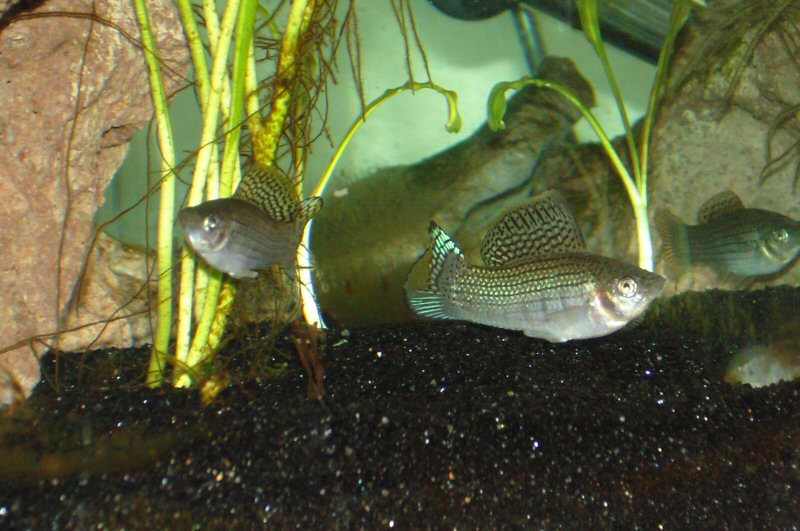
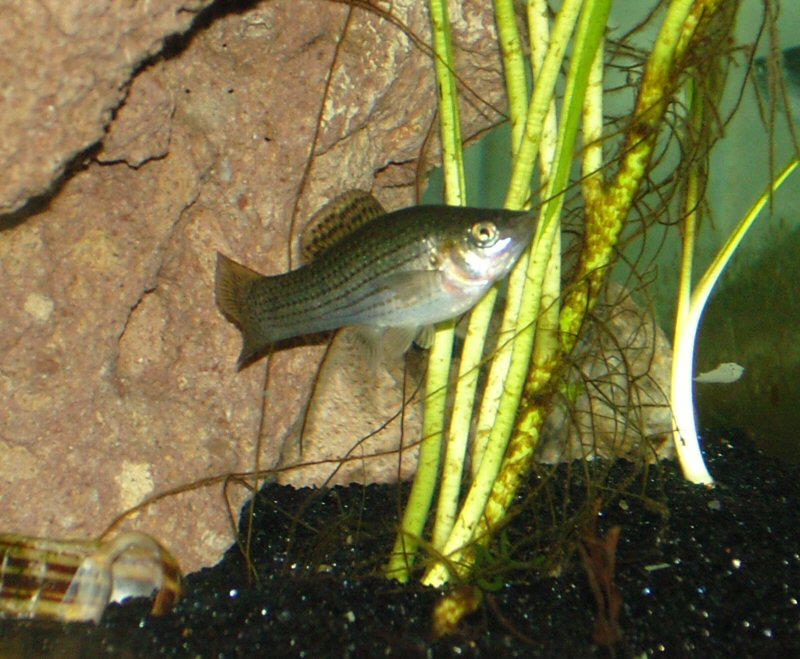
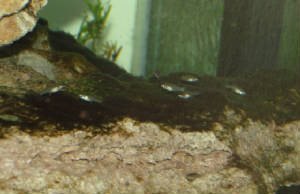
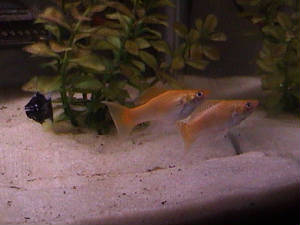
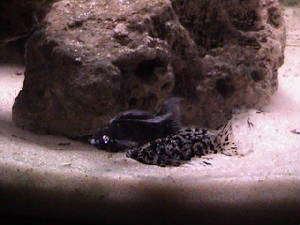
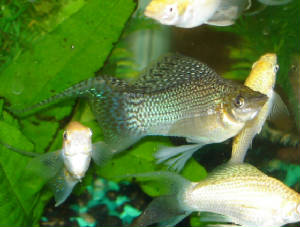
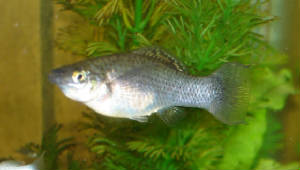
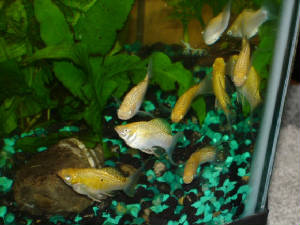
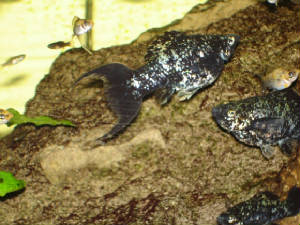
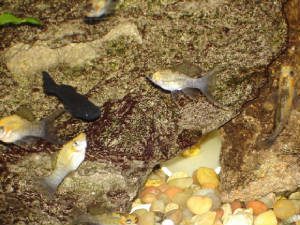
Read-up!! This is all the information you will ever need to know about mollies, plus a few pix.
Mollies
Poecilia sphenops - Common Molly
Poecilia latipinna - Sailfin Molly
Care: Feed with vegetable-based flakes. They are primarily a vegetarian but will accept most aquarium foods. Don't clean algae off back glass, as Mollies love to munch on it. Many plants and some salt in the water will do the fish well. They will be better off in brackish water, especially black mollies. A good salt ratio to use is 1 tablespoon aquarium salt to 5-10 gallons of water. They are somewhat piggish.
Breeding: Mollies are livebearers. Although they are harder to breed than Swordtails and Guppies, their breeding is still prolific. Babies will feed on zucchini cut into cubes, or just some crushed flake food. Some salt in the water will help with breeding, increase growth rates, and add more colour. The female will drop live fry in intervals of between 4-6 weeks after a 3-4 week gestation period, depending on temperature of the tank. Fry can be raised in the same tank with parents as long as no other species of fry eating fish are present.
Sex: Sex can be determined by the male's modified anal fin (gonopodium). If there is an organ that looks like a stick or straw in place of the anal fin, it is definitely a male. If it's only a fin, it's a female. Males are usually slightly smaller than females, although male mollies will stay smaller in an overcrowded tank. The sex of the fry shouldn't be determined because they all look like females in the beginning. They will either stay female, or change to male. The change should be apparent by 3 months of age.
Temp: 75 - 82°F (25 - 28°C)
Babies: Babies need a tank that is at least 10 gallons, or they won't grow at a normal rate. They need lots of hiding spots in an aquarium as to escape parents who sometimes eat their young. Sex can not be determined until roughly 3 months of age, at which time the males will have developed the gonopodium.
Comments from experts: The amount of salt recommended is 1 tablespoon per 5-10 gallons of water. For every male there should be 2-3 females. If there is only one female, the male will constantly impregnate her and stress her out. When a female is separated from a male, she may impregnate herself up to three times, being able to store sperm inside of themselves. If you don't have many other fish, don't worry about removing a pregnant female from your tank. Live plants will help with her birth. Females tend to choose mates that are smaller compared to themselves. If you do plan to breed mollies, or any other live-bearing fish and want to in succession, always have more than one tank. One tank can be a maternity ward, one can be a tank for babies, and so on.
Mollies like it warm (78-80), and salty. I use marine salt, 1 tblsp. / 5-10 gallons, for my molly/cichlid tanks. That's not all that salty but it seems to keep them happy (they spawn, an occasional fry makes it to adulthood, they're never ill). A 2.5 gallon hex is a lousy tank - it has the surface area of a teacup. Get them a bigger tank, at least a 5 gallon, normal dimensions. You can put a small submersible heater (I like Ebo-Jagers) in it, along with a home-made breeding grate. To make the grate, use aquarium-safe silicone sealant and glue two strips of clear plastic corner molding to each long side, about 1/2 way up. After two days, you can rest a piece of fluorescent egg-crate grating on it. Put in a sponge filter that's been aged in an existing tank. Put in a bunch of scruffy java moss below the egg crate. Insert molly pair. Stand back. The egg crate prevents the parents from getting the babies. Wait till they've spawned, and you can remove the parents and grate and have a good rearing tank. Don't forget the salt! [of course breeding grate is not always necessary, just a comment from an expert on their technique].
Females about to give birth can be recognized by their round, tight stomachs, which late in the pregnancy become squarish in shape (like this: \____/ ). Black mollies can be identified easily by a white spot behind their pelvic fin; others by a black spot (the gravid spot). Personally I find the commercial breeding traps ideal for the pregnant female. If placed too late in pregnancy, the female can die, and the fry can be damaged. But, if placed to early, she may get too stressed out and abort the pregnancy. A small separate glass or plastic tank with plenty of hiding places can also be used. In this way the female can be placed a week or more before giving birth. The female would be too tired to start chasing her fry immediately and she can be distracted from doing so by feeding her. Unless exceptionally predacious, the female can be given a day or two of rest in this tank. [though my experience with breeding traps is that they stress the females out too much and she aborts the pregnancy]
